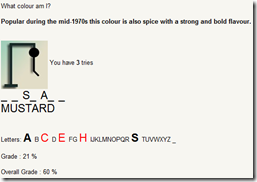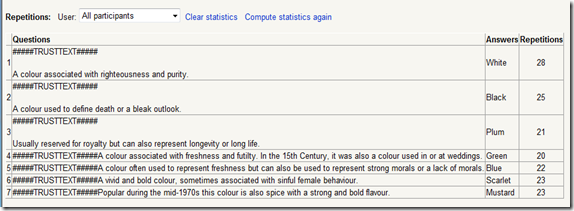So I created the Moodle games and set the Year 7 students at ’em. At the start of the lesson, these young students were informed that ‘we’ were embarking on a learning experiment. I explained that I had created a range of learning games, presented them on the VLE, and their ‘job’ was to play them and assess their value. I purposefully did not set the games within the context of our current unit of work, Cluedo, but rather just let them attack them with verve.
What did I learn?
Comments were generally positive, ‘I liked it,’ ‘I thought it was cool,’ ‘good,’ ‘fun,’ and ‘challenging.’
There is a connection between fun and success, with Hangman probably the easiest and most familiar getting the most positive results. Therefore, a few very simple answers will help these students build confidence.
Year 7 students are not familiar with crosswords, why should they be? Most do not know how to approach solving crosswords and most were not aware that you can proceed with solving crosswords, with wrong answers in place.
For example the crossword – when you put the word you want to put in, it lets you, even if it is the wrong word.
Two students resorted to research to get the answers. Now, IMHO, that’s learning.
Report
The reports were very powerful. In addition to basic information, when, how long and grade, (not forgetting that grades are also automatically pushed through to the gradebook), you get an insight into student thinking, error correction and therefore understanding.
In ‘Show Attempts’ uou also get a measure of their learning resilience, giving an indication of those students that persevered and those that threw in the towel. In this instance it also showed that Aphrael had revisited the games, twice that evening, to improve her score and it was not even set as extended learning.
 In Hangman, for example, the error attempts are shown in red. From this information you get an insight into the process the student followed to reach their answer.
In Hangman, for example, the error attempts are shown in red. From this information you get an insight into the process the student followed to reach their answer.
Finally, you get feedback on the quality of your teaching / questioning. In this instance the ‘white’ question was answered most successfully, however I am please with the low variance in the students responses, suggesting the topic was taught equally well or the questions were pitched with good equality.
Not forgetting that these statistics can be filtered by group, by individual and exported. The games may look a little lightweight, but the outcomes pack a heavyweights punch.
Last but not least, students were not familiar with blogs and leaving comments. After moving 6-7 comments to ‘Better Learning Rates for Your Moodle Investment,’ I notice I still have significant task in supporting these students develop the core English skills, particularly their spelling.
[qr_code_display]



